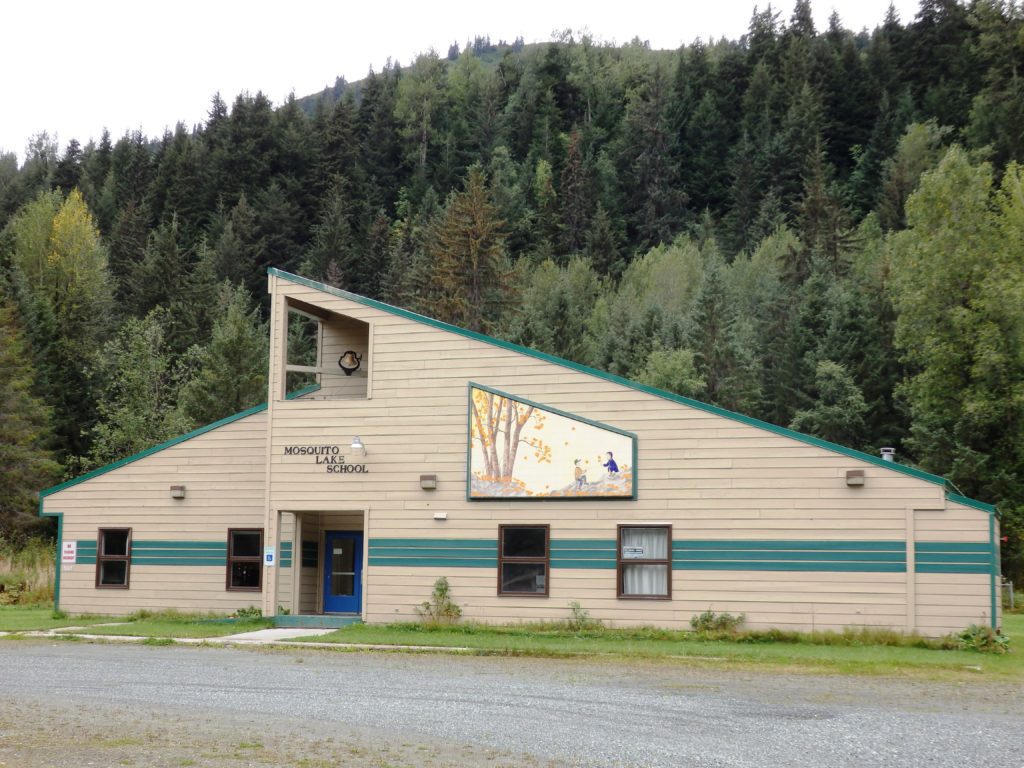
Miniature totem poles were carved in the early 1900s as popular items for tourists, but some replicated full-size totem poles and are the only record of the original today (Corinne Smith/KHNS)
The Haines Sheldon Museum will feature a new exhibit of Lingít miniatures, which will showcase not only the artistic works but also stories of Lingít people forced to adapt to the rapidly changing times of the late 19th and 20th centuries. KHNS’ Corinne Smith reports.
The new exhibit will feature a variety of Lingít miniatures, drawn from the Haines Sheldon Museum’s own 23,000 item collection. That includes small-scale items like totem poles, canoes and dolls, which were popular as children’s toys. Items were both artistic and practical, says museum collections coordinator Zachary James.
“Small spiritual figures, kind of talisman like objects, amulets, rings,” James said. “And then halibut hooks too.”
James is Lingít, with ancestry in the Chilkat Valley, Wrangell and Stikine Basin. He points out a doll with a stone face and calico dress. With the introduction of Western culture, he says the designs and materials used show how Lingít people took them and adapted them to new art forms.
“After Western contact, and the fur trade, there was a real explosion of art from Southeast Alaska and just Northwest Coast,” he said. “Because increased wealth, more trade, new materials, steel became widely available. And so it was easier to produce more carvings, and new ideas were coming in too. And within the old traditions, they would take these new ideas and make new things.”
With the onset of Russian, European and American traders in Southeast Alaska throughout the 1800s, Lingít people traded and adapted new materials into cultural practices, clothing and art.
“The people were still living totally in a native economy, you know, native society, native principles, native ideas,” he said. “But they would take what they wanted from the newcomers, the new ideas, new materials, and then make it their own. Same thing with regalia. Beads traditionally, it was porcupine quill beads or shells, but with the new materials, a whole new set of ideas, a whole new set of patterns, a new art form was created, just from just from the introduction of new materials.”

Booklet published by the Pacific Coast Steamship Company (Corinne Smith/KHNS)
Steam ship tourism kicked off in the late 1800s, with mostly wealthy European and American tourists making the long journey to Southeast Alaska. James points to a 1905 pamphlet advertising ‘Alaska via the Totem Pole Route’ where ships visited different villages to see original totem poles.
“(The assumption was) either Native people needed to assimilate to a cash economy or they would disappear. But either way their old traditions wouldn’t survive,” James said. “That was how they promoted it, as ‘see the Native in their natural habitat before they disappear,’ which we know that to be not true now, but it was the thought at the time.”
James says starting in the late 1800s with the Klondike Gold Rush and massive influx of missionaries and settlers, fish traps decimated salmon runs and harmed traditional Native livelihoods. So Lingít artists began producing miniatures for tourists.
“So all of these things were going on. It compromised the traditional economy and the Lingít people here. So a lot of people turn to producing souvenirs for steamship travelers as a way to supplement their income.”
Lingít people, mostly women, would set up on the docks and sell to tourists.
“We have a lot of old photographs from steamship travelers, and it’s almost always women who would be selling their wares,” James said. “And amongst the baskets that the women weave, they would have small totem poles and small carvings that the men made.”
James says Lingít people may have moved into small-scale art for sale as an act of economic survival, but at the same time the style and craft was exquisite. And, miniature totem poles are sometimes the only surviving record of full sized totem poles in existence today, representing important stories and crests of the 30 foot originals.
“A lot of the model totem poles were based off of real totem poles that existed, that had stories and were owned by someone,” he said. “So sometimes, the model totem pole, based off the real one, the model is the only one that exists today. Because, it’s easy to store, it lasted longer than the original. So that’s the only record of that totem pole existing, is in that miniature version.”
James says the exhibit will showcase stories of the known carvers, and provide the public an opportunity to learn more about Lingít people of the early 1900s in a time of cultural oppression and change.
“Understand the time period, and what people were going through at that time. What kind of pressures the culture and the art was under at that time period, what they had to do in order to keep making the art,” he said.
Though an exhibit of miniatures, the stories and legacy of Lingít arts are larger than ever at the Haines Sheldon Museum.
The exhibit on Lingít miniatures opens at the Haines Sheldon Museum on Friday March 25, and will run for eight weeks til the end of May.








